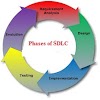Phases of System Development Life Cycle (SDLC):
The commonly used SDLC phases in System Development Stage are:1. Planning:
The Planning phase is the most crucial step in creating a successful system, during this phase it is decided that exactly what you want to do and the problems you’re trying to solve, by:- Defining the problems, the objectives and the resources such as personnel and costs.
- Studying the ability to propose alternative solutions after meeting with clients, suppliers, consultants, and employees.
- Studying how to make your product better than your competitors. After analyzing this data, you will have three choices: develop a new system, improve the current system or leave the system as it is.
2. Feasibility Study:
The feasibility study is an important phase of SDLC. In this phase, we study that whether or not the project is beneficial/possible or worthy if it can be implemented, given the existing budget and schedule.A feasibility study is the total of the actions you take and the questions you ask to determine whether an idea, thought or plan is likely to succeed. An effective study can guide you on whether you should move forward with your project, refine it or leave it.
3. Analysis:
In the analysis phase the end user’s requirements, need to be determined and documented, what their expectations are for the system, and how it will perform.The objective of the Analysis phase is to define in more detail the system inputs, processes, outputs, and interfaces. At the end of this phase, the system’s processes will be defined at the functional level, meaning the functions to be performed will be known.
4. Requirement Engineering:
The process of gathering the software requirements from the client, analyze and document them is known as requirement engineering. The goal of requirement engineering is to develop and maintain a document that defines the functionality of the developed system in all aspect.
Requirement Engineering phase actually defines all the components of software. In this phase the question “How the developed software looks like and what function it will do?” is answered.
5. Design:
In systems design, the design functions and operations are described in detail, including screen layouts, business rules, process diagrams and other documentation.
In the Design phase, the functions of parts of a software system are designed by using flowcharts (diagrammatic representation of a computer program), algorithms (set of steps to perform a task) etc. The main aim of the Design phase is to facilitate the coding process.
6. Coding:
Once the design is complete, most of the major decisions about the system have been made. The goal of the coding phase is to translate the design of the system into code in a given programming language.
This code is written is a formal language called a programming language. For a given design, the aim of this phase is to implement the design in the best possible manner.
7. Testing:
Software testing is the process of evaluation a software item to detect differences between given input and expected output. Also to assess the feature of A software item. Testing assesses the quality of the product.
Software testing is a process that should be done during the development process. In other words, software testing is a verification and validation process.
8. Implementation:
After having the user acceptance of the new system developed, the implementation phase begins. Implementation is the stage of a project during which theory is turned into practice. The major steps involved in this phase are:
- Installation of Hardware and Software,
- Conversion, and
- User Training.
9. Maintenance:
Keeping the system in its proper working condition is called maintenance. In other words, it can be defined as the modification of a software product after delivery to correct faults and to improve performance. Maintenance process continues until a complete solution is provided to the customer.






0 Mga Komento